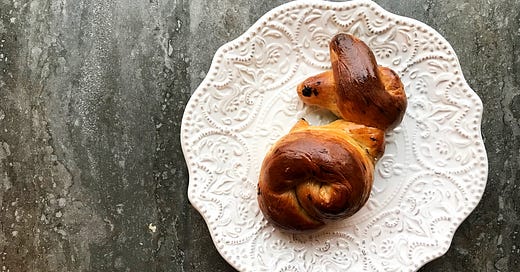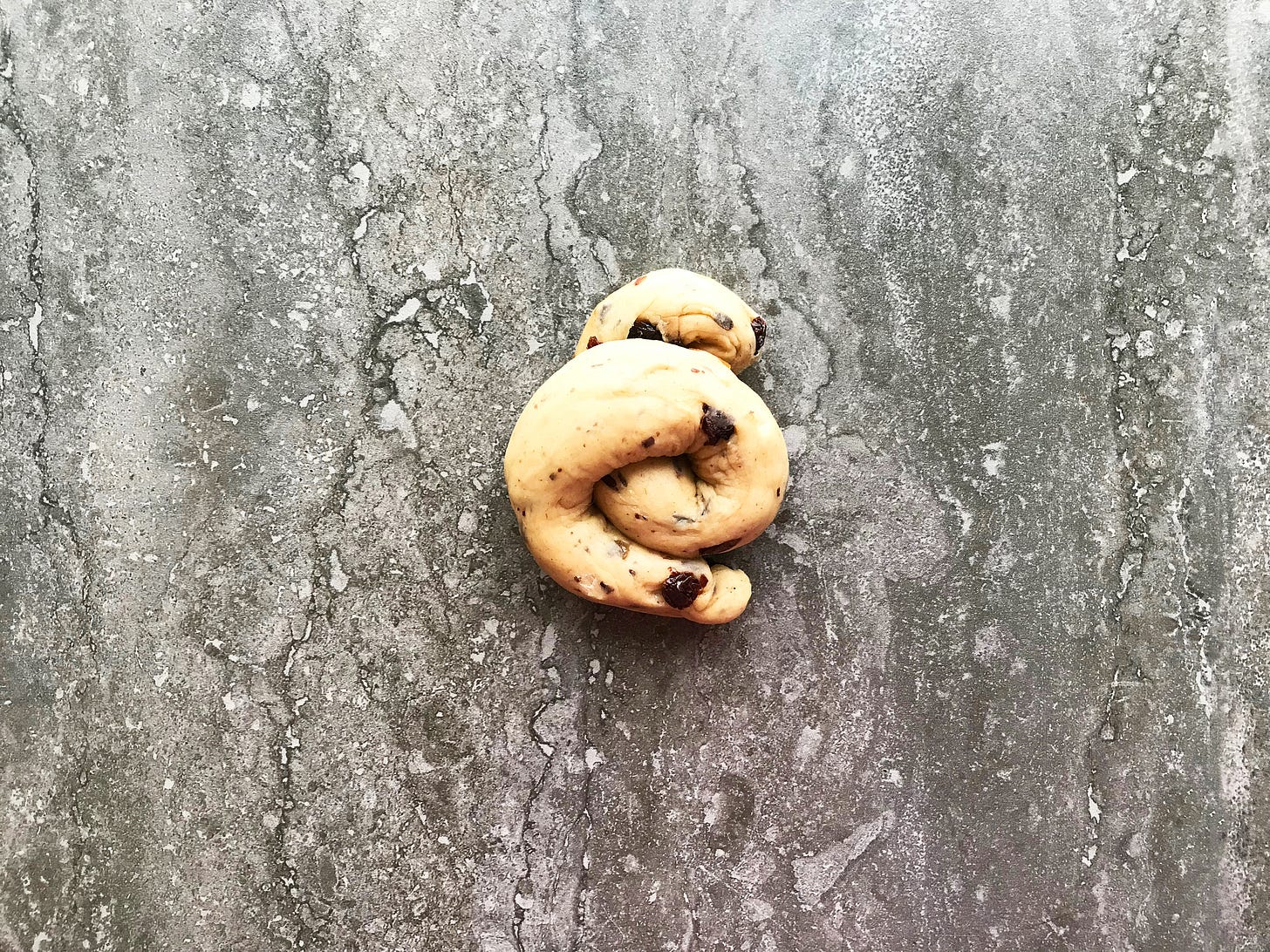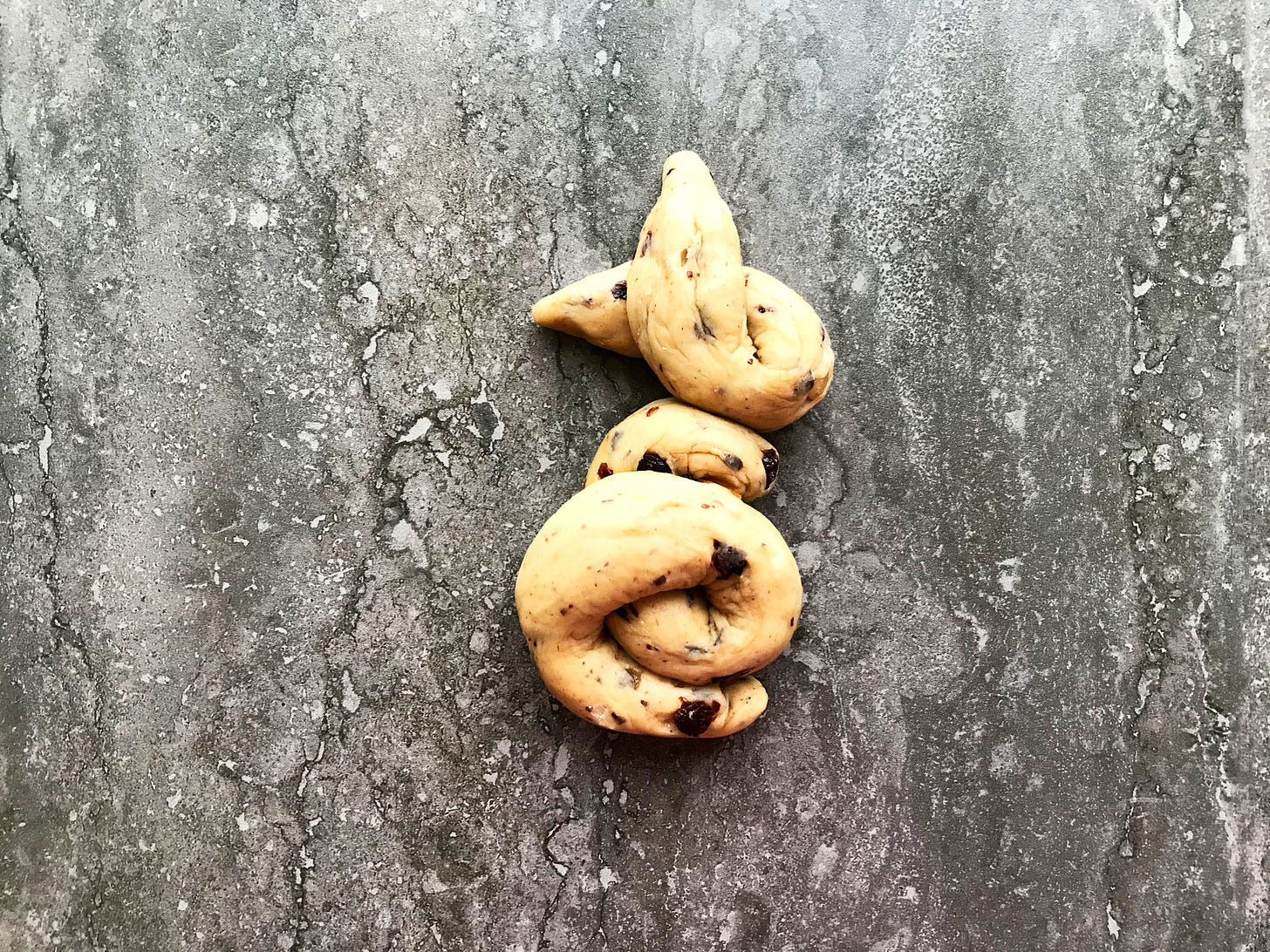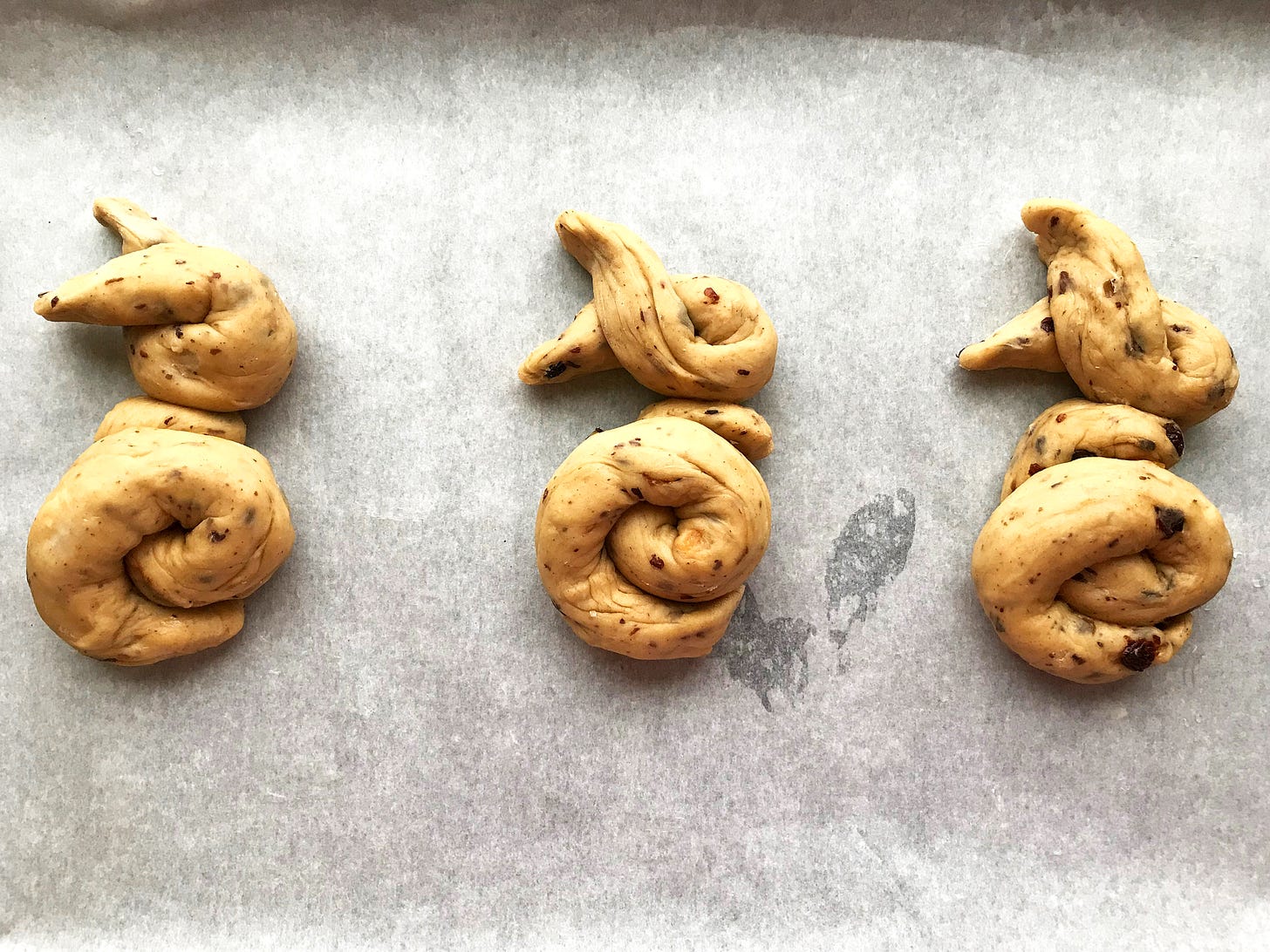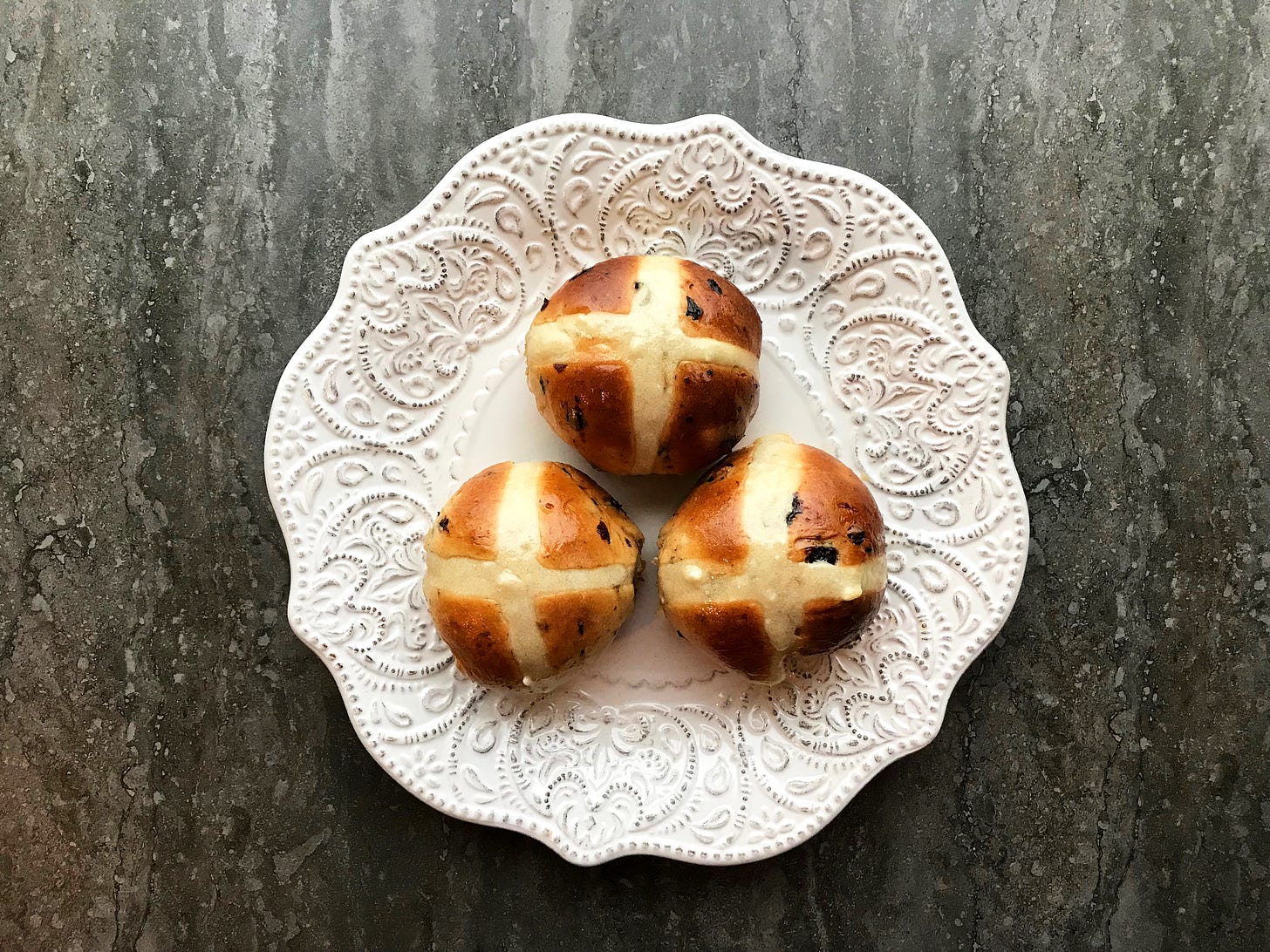Hello! If this is your first time reading my newsletter: thank you for popping by – you’re more than welcome here. If you’re returning, welcome back!
Instead of my usual meander, today’s dispatch is more of a how-to for a wee bit of hot cross bun creativity. I’m also giving you my hot cross bun recipe – you can decide whether yours will be buns, bunnies, or something else.
If you enjoy this newsletter, please subscribe and share.
Hot Cross Bunnies
I don’t have many Easter traditions. Sometimes, I’ll warble through Jesus Christ Superstar. Sometimes, The Ten Commandments gets put in the DVD. The meal changes every year. The only constant is hot cross bunnies.
I use my usual hot cross bun recipe (yes, buns are made as well). But the dough is twisted, contorted, and baked into vaguely bunny-like shapes.
I say vaguely, because yeasted dough can take a life of its own once in the oven. Ears untwist. Bunny bums and bellies swell in unexpected ways (but really, whose don’t?). I stopped inserting raisin eyes because they kept shooting out from their little faces during baking. They can emerge from the oven a little Quasimodo-like, but that’s part of their charm.
Building the bunny
You can make hot cross bunnies with any dough that will hold its shape you have (my hot cross bun recipe follows). Size really doesn’t matter.
If you’re using a yeasted dough that requires two rises, form the bunnies after the first one.
For each bunny, you’ll need two ropes of dough, with one being about half the length of the other.
1. Make the head with the shorter rope by crossing the two ends so you have a loop with two ears.
2. Make the body with the longer rope by making the same shape as the head, but one end should be shorter than the other. Let the shorter end rest on neck-side the coil and curl the longer end around the bottom, so it forms the body.
3. Wet your finger with water and rub it on the neck and the bottom of the head and lightly press together. Pull the ears a bit so they don’t contract too much during baking.
4. Place bunnies on the baking sheet giving them enough room to grow as they go through their second prove and bake. Glaze immediately after baking.
New from me:
· Nothing!
What what I’m reading, and foodish things I’m doing:
· A few things have appeared that are taking up my free time and will leave me preoccupied for a few weeks.
Hot Cross Buns
I never really liked (shop-bought) hot cross buns until I started baking my own. This is an easy and adaptable recipe: All milk, instead of water and milk; change up the spices or dried fruit (or don’t use either); if you don’t like mixed peel or don’t have any, use lemon and orange zest instead. I’m offering two ways to make the cross – cut them into the buns before the second rise or mix a flour paste and pipe or spoon the crosses on before baking. The sweet glaze will help keep the buns fresher longer – just remember to brush them as soon as they come out of the oven.
Preparation time: about 20-30 minutes
Proving time: about 1½ hours
Cooking time: 15 minutes
Yield: 12 buns
For the buns
75 g (approximately ½ cup) dried currants
Boiling water, as needed
55 g (¼ cup plus one teaspoon) sugar
150 ml hand-hot water
10 g (1 tablespoon) traditional/active dry yeast
450 g (3 cups) all-purpose flour (plus more, as needed)
½ teaspoon salt
¼ teaspoon ginger powder
¼ teaspoon mace powder
¼ teaspoon cinnamon powder
¼ teaspoon cardamom powder
50 g (approximately 2⁄3 cup) mixed peel
60 ml hand-hot milk (plus more, as needed)
1 beaten egg
55 g (¼ cup) butter, melted
For the paste or the crosses (optional)
85 ml (about ⅓ cup) water
75 g (½ cup) all-purpose flour
For the glaze
60 ml (1/4 cup) water
4 teaspoons honey
1 tablespoon orange juice (optional)
For the buns
Plump the currants by covering them with boiling water and let sit for about an hour. Drain before using.
About 10 minutes before the plumping is over, dissolve 1 teaspoon of sugar in hand-hot water. Sprinkle yeast over top and let a frothy head develop – this will take about 10 minutes.
Meanwhile, combine all-purpose flour, salt, ginger, mace, cinnamon, cardamom, mixed peel, and remaining 50 g sugar. Pour in the yeasty mixture, milk, egg, and butter. Knead, adding milk or flour as required to get a firm, slightly sticky dough –about 5 minutes in a stand mixer. Cover and let rise in a warm spot for about an hour or until it doubles in volume.
While it doubles, line and grease (or just grease) a baking tray or a 33 cm x 23 cm (13” x 9”) rectangular baking dish.
After doubling, punch down the dough and knead for a couple of minutes so it’s back to its original size. Divide into 12 equal pieces, roll into balls, and place them on the prepared tray leaving plenty of room for expansion.
Optional: if you want to cut the crosses into the buns, do so now, deeply, with a sharp knife.
Cover lightly with greased plastic or a damp cloth and let rest in that warm spot for 30 minutes or until the buns double in size.
While the buns prove, preheat oven to 220C/425F
For the paste for the crosses (optional)
Make the paste by adding one tablespoon of water at a time to the flour until a medium-thick paste forms. Spoon into a piping bag fit with a small nozzle and pipe a line along each row of buns, then repeat in the other direction to create crosses. You can always spoon the mark on by hand, if you have the time or inclination.
Bake for 15 minutes – the tops will be golden and the bottoms may be little darker.
For the glaze
While they bake, add water, honey, and orange juice (if using) into a small saucepan and bring to a boil for 7 minutes, stirring occasionally. Turn off the heat and let sit.
When the buns are done, brush them with glaze as soon as they come out of the oven, so they’ll be nice and sticky.

